ESG momentum and financial motivators combine to stimulate greener frac operations
In today’s rapidly changing business and social environment, the oil and gas industry must adapt to a new reality for hydraulic fracturing operations. Amid overriding macroeconomic forces that have recently wreaked havoc in the industry—including demand destruction caused by the COVID-19 pandemic, coupled with uncertainty over OPEC+ production policies—yet another long-term challenge is gaining momentum. In little more than a year’s time, the push for producer/operators and service companies to adopt greener oilfield operations has intensified significantly. By its nature, this push could eventually render a tried-and-true staple of the oil field obsolete: diesel-fueled frac fleets.
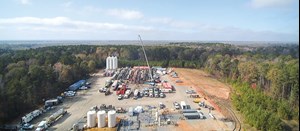
Although oilfield companies have striven proactively for many years to provide cleaner, safer operations, there has always been outside pressure to adopt and drive a greener oil field. In the recent past, this pressure came almost entirely from regulators and environmental groups. While timely implementation was required, the pace was typically measured and categorized by smaller achievements over time. Today, many of the largest investment funds are increasingly and staunchly focused on environmental conservation, and they will invest only in like-minded companies. This base of investors expects oilfield players to accomplish environmental, social and governance (ESG) progress at a much quicker pace, which places a greater impetus on reducing emissions, fuel consumption and overall carbon footprint.
In fact, a recent study concluded that global assets applying ESG data to drive investment decisions have nearly doubled over the last four years, to more than $40 trillion in 2020.1 Within the U.S., ESG investments now account for approximately one-third of the country’s total assets under management, marking a more than 40% increase, compared to 2018. Climate change is one of the most important ESG issues cited by institutional and retail money managers, including those overseeing the tremendous amount of assets invested on behalf of insurance and educational institutions.2
Providing a cogent reminder of investors’ influence and intent, BlackRock, one of the world’s largest global investment managers, noted in a recent corporate publication that the firm will “engage more deeply and more often with companies in carbon-intensive sectors on climate-related business risks and opportunities.” The publication continues, “In the year to June 30, 2020, we focused on a universe of 440 carbon-intensive companies… (and) in addition to voting against 55 directors, we put 191 ‘on watch,’ meaning they risk votes against directors in 2021 unless they demonstrate significant progress on the management and reporting of climate-related risk. Beginning in 2021, our expanded focus universe will cover more than 1,000 companies.”
While many producers and service companies already operate under the tenets of longstanding and sincere commitments to environmental stewardship, their businesses are under ever-greater scrutiny from ESG-minded investors. This is particularly true in terms of a company’s environmental impact—both real and perceived—these investors can have significant influence on the larger investment population. As a result, their public disapproval of a corporation can dry up incoming capital quickly and deplete share prices.
Building on a long history of oilfield innovation. Whether the goal is to solve difficult challenges or to improve current best practices, the oil and gas industry is no stranger to inventing new ways of getting things done. The advent of horizontal fracturing itself—along with continual and rapid advancements in fracturing technologies since that time—provides relevant and timely examples of this inventiveness.
That same spirit of innovation is alive and well in the industry’s current environmental efforts. For example, well before Keane Group and C&J Energy Services merged in fourth-quarter 2019 to become NexTier Oilfield Solutions, each of the two legacy companies had already begun replacing diesel-fueled fleets with greener, more efficient dual-fuel fleets, which substitute much of the consumed diesel fuel with natural gas.
“Before there was even talk of a merger, Keane and C&J already had similar mindsets in anticipating what our customers were going to need in the near future,” explains Kenneth Pucheu, Executive Vice President and Chief Financial Officer at NexTier. “The fact that we were both making the transition to dual-fuel technology was definitely a plus for our customers, and the merger enabled us to significantly expand available dual-fuel horsepower in our fleet.”
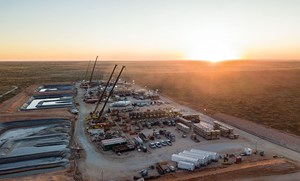
From a distance, most observers would likely mistake dual-fuel frac equipment for the diesel-powered machinery that has dominated the frac-field landscape for decades, Fig. 1. However, the modified engine of a dual-fuel frac unit has the distinct advantage of being able to replace much of its diesel fuel supply with natural gas. The engine can run on pure diesel, but it also can be fueled by both diesel and natural gas simultaneously. Because diesel is always required to initiate a combustive spark, it is not possible to run a dual-fuel engine solely on natural gas. To help optimize pumping performance and efficiency, when the engine is running on combined diesel/natural-gas power, the intake system automatically adjusts the mixture ratio in real time.
Sparking widespread adoption of dual-fuel technology. Based on NexTier customer data, operators can easily spend between $8 million and $12 million per year in diesel fuel to power a single conventional frac fleet. The dual-fuel solution not only reduces producers’ diesel consumption, but it also offers a more cost-effective use of their readily available natural-gas reserves. Compared to piping natural gas to a collection point and selling it at a low margin, or flaring the gas in locations lacking an economically feasible transport option, using reservoir gas to supplement a frac fleet’s fuel supply can potentially provide significant cost benefits. In 2013, to accommodate customers who wanted to take advantage of this opportunity, NexTier legacy service companies rolled out their first dual-fuel fleets in gas-heavy Northeastern U.S. shale plays. Over the next few years, demand grew steadily.
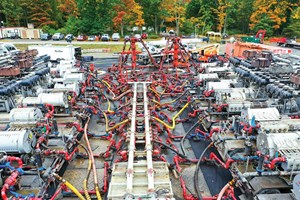
On top of the economic benefits, operators appreciated the fact that, because natural gas is much cleaner than diesel, dual-fuel fleets had the potential to help reduce the environmental impact of their operations, Fig. 2. In fact, although cost was originally the primary motivation to increase use of natural gas to fuel the frac field, environmental advantages quickly became the main driver. This shift resulted from the rising influence of regulatory changes, producers’ own ESG commitments and increasing focus from the investment community.
To meet the growing demand, both Keane and C&J began growing their dual-fuel fleets. The companies then consolidated their dual-fuel inventory through the 2019 merger, and since then, NexTier has continued to add capacity. According to the company’s internal assessments, NexTier currently holds a leading position in dual-fuel frac equipment, based on the number of deployed fleets in the continental U.S., Fig. 3. Still, the demand to replace diesel fuel with natural gas far surpasses the available equipment supply. Of the frac fleets operating on U.S. soil today, only an estimated 30% of those fleets are equipped with the ability to power the pump engines with natural gas. Part of the reason for this deficiency in supply is that dual-fuel fleets cost considerably more than diesel-fueled fleets—an additional investment of several million dollars—and a majority of service companies simply can’t afford the capital investment in today’s challenging, low-margin market.
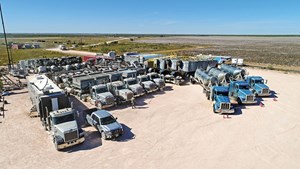
“At the moment, most fracturing companies have resorted to cannibalizing their existing diesel equipment for maintenance, as a measure to preserve positive cash flow,” says Nathan Carrell, Vice President of Hydraulic Fracturing at NexTier. “In other words, instead of spending the capital to perform maintenance or rehab on diesel equipment, companies are pulling engines and other components from stacked equipment, and parts that are worn or left over are simply scrapped. Eventually, we believe the entire industry will phase out diesel-only combustion in favor of dual-fuel pumps.” However, Carrell notes that widespread transition won’t be plausible until the industry sees significant recovery. “Before the majority of service companies can throw their hats in the ring, they need the market to return to pricing that generates positive cash flow for reinvestment. NexTier follows an agile business strategy to maintain a strong balance sheet—and that puts us in the unique position of being able to make those investments now.”
Not all dual-fuel frac equipment is created equal. The amount of diesel that can be replaced by natural gas varies, depending on a combination of several factors. These factors include the overall build quality and EPA emissions rating of the engine, the efficiency of the dual-fuel intake system, the ratios of methane and other components in the natural-gas supply, the pressure of the natural gas being introduced into the fuel mix, and the load under which the engine is operating. Additionally, the technical competency of the on-site personnel, including fuel-management expertise, plays an important role in reducing diesel combustion.
Explains Aaron Hilber, NexTier Vice President of Power Solutions, “There’s a variety of different configurations out there when it comes to dual-fuel equipment, and unless it’s built to the highest standards, you’re not going to achieve the optimum results you’re looking for. You can add a third-party kit to convert any diesel unit to a dual-fuel unit,” he says. “But the best performance comes from a Tier 4 engine, with a dual-fuel kit made by the same company that built the engine. This enables a fully integrated system with real-time control and feedback between the engine and the natural-gas fuel train.”
EPA emissions ratings for fracturing equipment fall within the “nonroad diesel engine” category, and a majority of active fleets are rated either Tier 2 or Tier 4. In terms of both operational efficiency and environmental impact, Tier 4 engines are the top performers. They operate under the strictest emissions limits for nitrogen oxides, non-methane hydrocarbons, particulate matter and carbon monoxide. According to Hilber, a Caterpillar Tier 4 engine, matched with a Caterpillar conversion kit, achieves the highest level of diesel replacement—up to 85%. Various manufacturers’ Tier 2 engines can replace up to 65% of diesel when paired with a same-manufacturer kit. However, “Using a third-party kit, you’ll max out at 45% to 50% diesel replacement,” notes Hilber, “regardless of whether the engine is Tier 2 or Tier 4.” That means you can’t achieve nearly as much reduction in fuel costs and carbon footprint. That’s why NexTier uses dual-fuel kits built by the engine manufacturer whenever possible. However, not all manufacturers have their own integrated dual-fuel kits. In that case, we choose the best available kit to maximize gas usage and emissions reduction.
An electric future? With ESG initiatives occupying an increasingly prominent position in today’s oil and gas boardrooms, the next aspirational step would be to eliminate diesel combustion in the frac field. While that concept may seem impossibly challenging, electric-powered pumping fleets make it achievable. These “e-fleets” build pumping pressure using electric motors and variable speed drives in place of the traditional diesel engines and transmissions. In most cases, however, an electric grid isn’t accessible from the field location—or, if a grid is within reach, it doesn’t have enough capacity to power a hydraulic fracturing operation. Therefore, the electricity needed to power the pump motors must be generated on-site. Fueled entirely by natural gas in the form of reservoir gas, compressed natural gas (CNG) or liquid natural gas (LNG), portable electric turbines are the most common source of field-generated electricity.
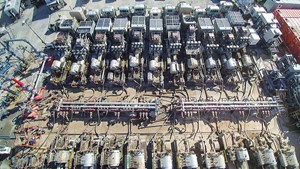
Critical to the successful operation of e-fleets and dual-fuel fleets is the ability to supply adequate gas volume, quality and expertise on the job site. It’s important to understand that every source of reservoir hydrocarbons has a different chemical composition, and many service providers are unaware that they can’t simply bring in raw reservoir gas to fuel these fleets, Fig. 4. Even in cases where sufficient reservoir gas is available, the supply must be tested—and often treated—on location, to ensure that it is suitable for use as fuel. In this aspect of alternate-fuel operations, the industry faces a steep learning curve.
Furthermore, many fields require CNG or LNG to supplement or fully replace reservoir-produced natural gas. This brings additional contractors into the mix in an already-complicated operation, so efforts among different providers often aren’t well-coordinated, and the pumping equipment doesn’t run at optimal performance. As a result, the operator isn’t able to achieve the full cost-saving and environmental benefits of fueling with reservoir gas.
Plugging in to capture the momentum of alternative fuels. Even the most sophisticated hydraulic fracturing equipment performs at the mercy of its fuel supply. Recognizing the critical importance of maintaining quality control, logistical coordination and fueling expertise, NexTier recently announced formation of its Power Solutions division. By integrating fuel management with hydraulic fracturing services in the eco-friendlier frac field, the company plans to help greener pumping technologies reach their true potential—while improving supply-chain continuity and overall cost efficiency for customers.
“From the ‘green’ perspective, staying relevant takes a lot more than just supplying carbon-friendlier equipment at the site,” notes NexTier’s Ian Henkes, Senior Vice President of Operations. “Customers expect our fleets to substitute gas at the highest levels possible, which makes it essential to have heightened communication among the critical moving parts. Any misstep in that chain leads to less-than-optimal blending, which results in a fleet that can’t perform to the customer’s expectations. The trends suggest that frac companies in the future will be graded pretty heavily on the amount of natural gas used on location. That means we not only have to continue advancing our alternative-fuel technologies, but we also need to take big steps to ensure the gas supply to location is rock-solid.”
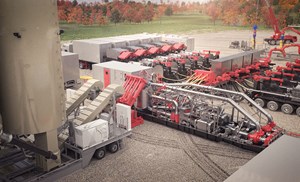
In the ongoing quest to eliminate diesel as the primary fuel source for frac fleets, NexTier has explored a variety of opportunities, both internal and external, to develop an e-fleet that would deliver optimized costs and maximum ecological benefits. Ultimately, the team recognized that a strong strategic partnership would enable the greatest reliability and speed to market in their efforts to deploy the most advanced equipment and technologies available. They found that partner in NOV and their Ideal eFrac fleets, Fig. 5.
“Partnering with NOV was a natural next step for NexTier to test e-fleet technology,” says Pucheu. “Considering their reputation for world-class engineering, technology and manufacturing—combined with their overall strength as a business—nobody else comes close. We’re really excited to partner with them to deliver a more eco-friendly frac field.”
Starting in first-quarter 2021, on behalf of one of the world’s top oilfield production companies, NexTier will put NOV’s first field-ready electric pumping unit to the test during a three-month trial in the Permian basin. “We have always believed that close collaboration with our customers is the key to any successful product launch, so the opportunity to partner with a company of NexTier’s caliber is a significant win for NOV,” says Scott Toler, Vice President of NOV’s Pressure Pumping and Cementing group. “NexTier’s track record of success and exceptional operational background provide an excellent foundation for our e-fleet field trial, and we’re excited to share in our joint commitment to improving frac and its environmental impact.”
Put your best fleet forward. As natural-gas-fueled pumping fleets become more commonplace, it’s likely that game-changing advancements toward greener frac fields will become more commonplace, too. NexTier is committed to a path of research and funding that optimizes the equipment and processes of using natural gas on frac locations. Ideally, widespread adoption of green practices will increase demand for cleaner fuels and related technologies, which will improve cost efficiencies and boost profitability for service providers and producers. Robert Drummond, NexTier’s President and Chief Executive Officer, agrees. “As an industry, we’re fully committed to making smart changes to improve the environment and to preserve our planet. And it’s no coincidence that those same changes also have the potential to improve and preserve our financial livelihood in the process. It always pays to do the right thing, and our eco-minded initiatives are a great example of that.”
REFERENCES
- https://www.pionline.com/esg/global-esg-data-driven-assets-hit-405-trillion
- https://www.etftrends.com/esg-channel/esg-investments-now-make-up-whopping-one-third-u-s-aum/

- Below-grade well cellar enables simultaneous operations in shale plays (November 2025)
- Breakthroughs in geothermal drilling: Eavor’s FOAK closed-loop commercial project in Germany (November 2025)
- Executive viewpoint: Investing in existing oil & gas fields is key to energy security and net-zero goals (November 2025)
- What LNG and AI mean for drilling in 2030 (November 2025)
- Weatherford’s strategic approach to directional drilling (October 2025)
- ZRF: The Zero Routine Flaring by 2030 initiative (October 2025)
- Subsea technology- Corrosion monitoring: From failure to success (February 2024)
- Applying ultra-deep LWD resistivity technology successfully in a SAGD operation (May 2019)
- Adoption of wireless intelligent completions advances (May 2019)
- Majors double down as takeaway crunch eases (April 2019)
- What’s new in well logging and formation evaluation (April 2019)
- Qualification of a 20,000-psi subsea BOP: A collaborative approach (February 2019)


